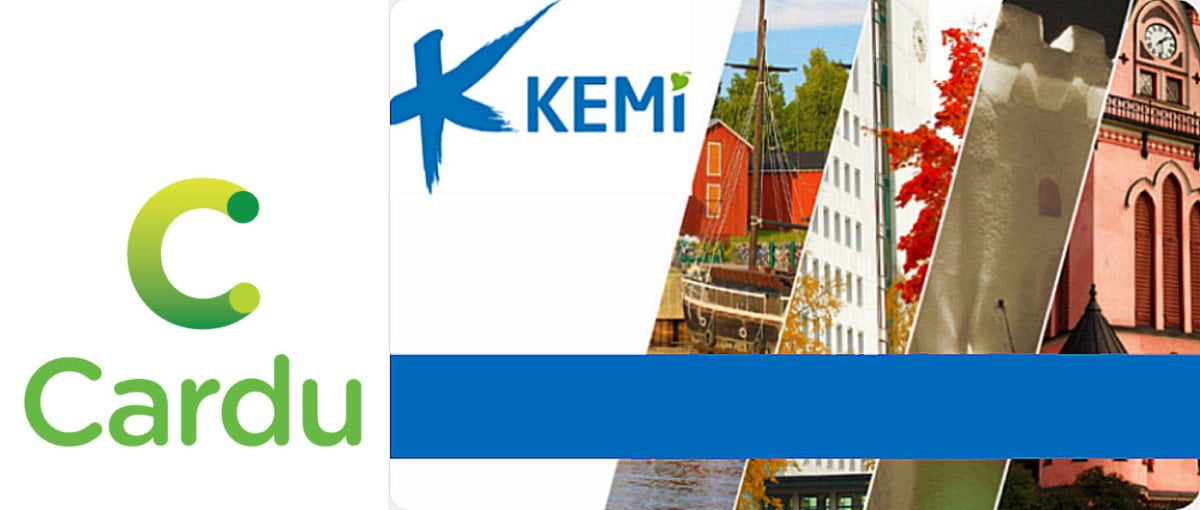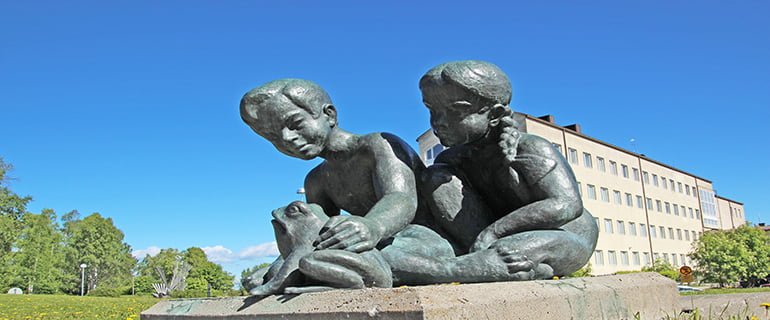Hyppäävät lohet (Jumping Salmon) by Ensio Seppänen (1968)
Fountain statue in front of the Hotelli Merihovi (Keskuspuistokatu 6).
Majakka (Lighthouse) by Kaija Kiuru (2002)
Hahtisaaren puistossa (Merikatu 12)
Located on a plaza near the motorboat harbour, the premise of the work is the form related to domesticity and stasis, in addition to anticipation and longing. The eponymous lighthouse gives light and shelter. The illuminated core shines through metal-carved boat names, come dark.
Quote from the artist: ”The theme of originates in images that I saw of refugee camps in 2001. 80 % of refugees are women and girls without a place to call home. What shelters them is often just a tent. This made me think about the true meaning of home[lessness].” A boat or a ship is a vessel, by means of which a refugee may get to safety.
Sotalapsipatsas Pieni ikuisuus (A Small Eternity) by Sanna Koivisto (1996)
Located by the downtown harbour (Rantabulevardi), Sanna Koivisto’s war-child statue A Small Eternity is likely the first of its kind in the world. On a concrete pedestal, there is a life-size bronze figure of a child. Squatting over an opened book, the child is in a foetal position draped in a blanket in a state of sorrow and fear. What is left behind is a safe home, mother, siblings and friends and what is ahead is a sombre sea, strange country and unknown future. The child expresses uncertainty and feelings of displacement and separation. The book stands for cultivation. It has been opened where children’s status is being discussed. Regardless of civilisation, children are subject[ed] to suffering. A nation has no right to call itself a civilised nation, before it has eradicated the suffering of any native child. On one page, there are children’s hands trying to grab other, safe hands. On the other one, there are longing mothers’ faces and hands. Plaques have inscribed on them the words of local heritage-preservation notables Elsi and Ossi Liiten: People / Peace is love / War is hatred / but the road to Civilization is love / it grows from the lap to the Heart.This war-child statue was erected by war children in the Kemi area in 1996 in memory of those that suffered in wars between 1938 and 1944, and as a reminder of children’s distress and suffering in warwaging countries [still].”
Ankkuri The Anchor of BB Kemi
The anchor lies by the swimming hall along Meripuistokatu Boulevard. In model, it is a stock or admiralty anchor. Being the last beacon boat in Finland’s waters, the anchor of is reminiscent of the Martin anchor, but the stock is straight. Kemi was built in Pori (or Björneborg) in 1901. It was called Pori until 1956, when it was sent to be stationed off Kemi. It was decommissioned in 1974 due to the construction of solid, automatic lighthouses along the route leading up to Kemi. The ship was renovated and placed in Hylkysaari, Helsinki as an attraction at its Maritime Museum in 1989. Today, the ship has a similar status at the maritime museum Vellamo in Kotka.
Ystävykset (Friends) by Ensi Seppänen (1960) Vänner
A bronze sculpture from 1960 sits right next to the entrance of Kemi spa, (Meripuistokatu 28). It is the first one to be commissioned from Ensio Seppänen in Kemi. The motif is children at play, a girl, a boy and a toad. Friendship may flourish in spite of timidity and ugliness. A toad is considered ugly and repulsive. Children, however, have no such bias. The boy, with more courage, holds his hand embracing the toad.
The statue was completed by 1960, and stored by the town until 1969, when it was placed on the patio in front of the swimming hall, finished a couple of years earlier, in conjunction with the Centennial of the municipality.
Ukkometto (Male Capercaillie) by Aimo Taleva (1982)
At the far end of Meripuistokatu Boulevard, near the swimming hall, lies Ukkometto by Helsinki-based sculptor and graphic artist Aimo Taleva, made in 1982. It was made in the metalworks dept. of the local technical school, with its original location in the school yard in Tervaharju. Its raw material is Outokumpu steelworks steel on a concrete pedestal. Its bird motif has features of traditional folk-art carpentry.
Rakentajapatsas (The Builders Statue) by Ensio Seppänen (1962)
Statue is located in front of the city hall, Valtakatu 22. A statue depicting father, mother and an infant is dedicated to the builders of Kemi People’s House. The adjacent wall depicts labour. The mother raises the child towards the father, whose right hand rests on his wife’s shoulders. Movements of the hands depict love and affinity within the family. The father is looking confidently in to the future. The memorial statue bears the inscription, ”This statue was erected in 1962 by Kemi Workers’ Assn. in commemoration of the builders of Kemi People’s House.”
Guided tours can be ordered from The Sea Lapland Tourist Guide Association.

Take over Kemi! Download the free Cardu application onto your phone and look for the Kemi Card. It offers an easy and up-to-date information package including events, offers, news, sights, history, activities and information about Kemi. You will have the entire town at your fingertips.
